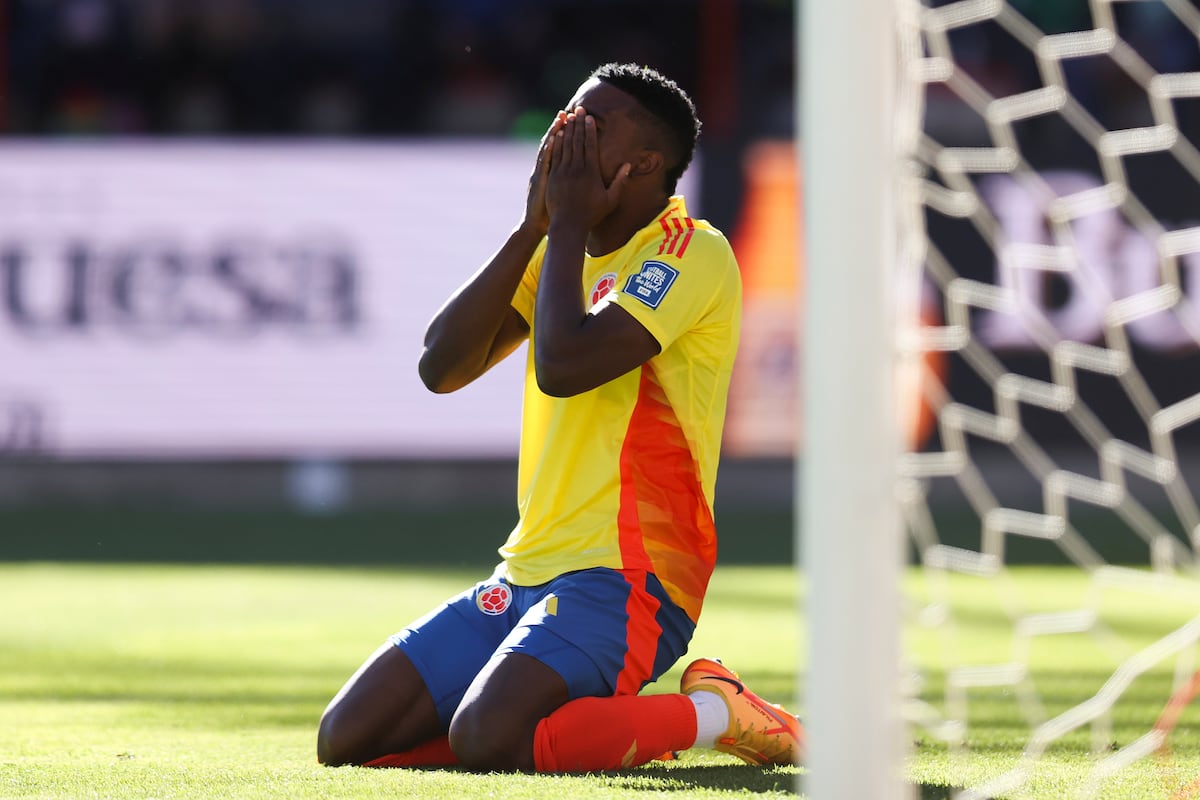If there were doubts that the Municipal Stadium of El Alto had become the ace up the sleeve of the Bolivian team to go to the 2026 World Cup, this Thursday it was confirmed: the highland team defeated Colombia 1-0 in its feared location, 4,150 meters above sea level. The only team that had not lost in the most difficult qualifying rounds in the world has fallen. And Bolivia, the former wild card of the qualifiers, has achieved its third consecutive victory, after having beaten Venezuela on the last two dates, also in El Alto, and Chile at home. Defeat does not mean danger for Colombia, which remains at the top of the table. It does represent a change for Bolivia, which partially rises to fifth place and begins to compete for a direct place in the World Cup to end the absence that began when it was eliminated in the 1994 World Cup, paradoxically also in the United States.
With the height set, the first half began with an intense sun that illuminated the entire rectangle of the playing field, and a Bolivian fan that pushed their team, emboldened after the victories of recent dates. Despite the possibility of calling up experienced players at altitude, Colombia’s coach, Néstor Lorenzo, opted to maintain the backbone of the team with which he reached the final of the Copa América and that maintained an error-free march in the eliminators, with James Rodríguez and Luis Díaz as the spearhead. In the days before the match, he was cautious, despite the emotional boost of the victory against Argentina last night and the statistic of not having lost in Bolivia for 21 years. The local team, led by Óscar Villegas, opted for a lineup made up mainly of players accustomed to the altitude.
The first actions of the game were predictable, but no less dangerous: Bolivia brought in its artillery and tested Camilo Vargas from medium distance: three powerful shots tested the Atlas de México goalkeeper, who knew how to respond by flying from stick to stick. Lorenzo, dressed in his cabalistic attire with a burgundy shirt, looked restlessly through his dark sunglasses. The ball ran fast on the field and made it difficult to control long passes, but Colombia reacted quickly to the Bolivian siege and five minutes into a game that was already looking intense, after a cross from the left sector, Roger Martínez sought to surprise the ball with his head. rival goal guarded by Guillermo Billy Viscarra. The shot, weak, did not represent danger. Bolivia once again looked for the goal from mid-distance, but always found a response from Vargas and the defense that supported them when the ball became uncontrollable.
The game, in which until then both teams tried in their own way and with their resources to gain some advantage, seemed to have a break with the expulsion of Héctor Cuéllar after a foul as the last defender against Roger Martínez, who had to leave injured. The Colombian fans remembered Cuéllar’s own violent foul against Luis Díaz in a friendly they played shortly before the Copa América in the United States, last June.
However, the Bolivians, supported by their followers in the stands of El Alto, continued looking to damage Vargas’ goal, and managed to break it, although the goal was disallowed for being offside. Colombia, wanting to take advantage of the extra player, tried to approach the Bolivian area from the sides. It came from the right, it came from the left, but nowhere did Jhon Córdoba, Martínez’s substitute, manage to convert for the coffee growers. Thus, at zero, both teams went to the locker room.
For the second half, Lorenzo changed the vocation of the team and took out Matheus Uribe to send Richard Ríos in search of greater weight in the attack. Soon the Palmeiras midfielder was present with a mid-range shot that goalkeeper Viscarra could not fully control, but Córdoba could not take advantage either, who did not look comfortable while he was on the field. Shortly after squandering that option, what popular tradition says about teams that do not take advantage of their scoring opportunities came true: Miguel Terceros faced the right sector, evaded three rivals and, with the lethal weapon of medium distance in height, he struck down Camilo Vargas with a corner shot, impossible to stop.
There was half an hour left, and Colombia could not make the extra player advantage count. Bolivia maintained order in defense, waiting for a counterattack that would allow them to put the game away. The tricolor insisted, from medium distance, from the sides, with James Rodríguez looking for solutions, devising a plan that would allow his team to rescue a tie that at 4,150 meters would have tasted like victory. Nothing worked: the headers who in other games have led the team to victory did not appear this Thursday. Long passes were becoming difficult, movements were increasingly shorter and slower, the team fell into despair. At minute 88, it seemed that the game still had history when Jhon Córdoba went for a header that passed less than three fingers from the ball, which continued straight and left the field. It was the last dangerous option in the game.
With the victory, celebrated wildly in the stands, Bolivia begins the October dates of the qualifying rounds on the right foot, in which, apart from Colombia, it will also face visiting Argentina on Tuesday. For now, it has 12 points in the table, and is placed fifth, waiting for what its closest runners – Brazil, Paraguay and Venezuela – do in their respective games. The tricolor, for its part, remains at 16 points, and hopes to turn the page on a match whose previous game was full of intrigue and unknowns due to the extreme conditions of El Alto, to receive the visit of Chile, beaten, in Barranquilla. With the highland team in the fight, the fight to go to the World Cup is tightening, and the six direct places, which seemed too much at first, are beginning to seem very fair.


